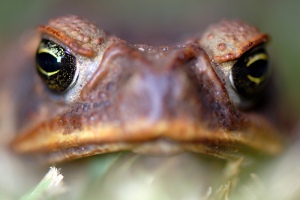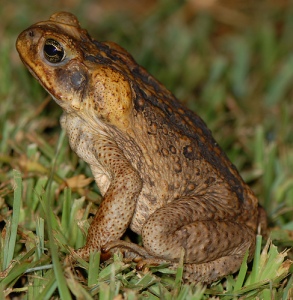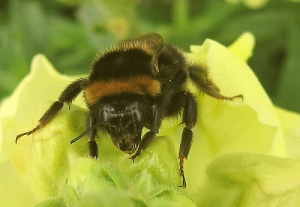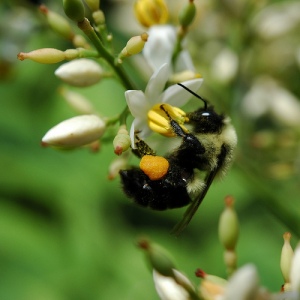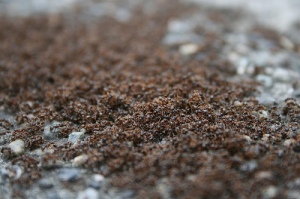 Ants are eusocial insects – they form permanent colonies where only the queen reproduces and all the individual ants are closely related to each other. The ants in a nest all have tasks to perform, such as raising the larvae or defending the nest from intruders. Male ants (drones) are solely present for reproduction; they usually have wings and form mating swarms with virgin queens, after which the males die and the queens lose their wings and essentially become egg-producing machines looked after by the workers. These worker ants are all offspring of the colony’s queen and are all sterile females – they are in fact more closely related to each other than they would be to any offspring and so they work to raise further ‘sisters’ produced by the queen.
Ants are eusocial insects – they form permanent colonies where only the queen reproduces and all the individual ants are closely related to each other. The ants in a nest all have tasks to perform, such as raising the larvae or defending the nest from intruders. Male ants (drones) are solely present for reproduction; they usually have wings and form mating swarms with virgin queens, after which the males die and the queens lose their wings and essentially become egg-producing machines looked after by the workers. These worker ants are all offspring of the colony’s queen and are all sterile females – they are in fact more closely related to each other than they would be to any offspring and so they work to raise further ‘sisters’ produced by the queen.
There are over 9,000 species of ant worldwide, with many different life strategies. Some species (e.g. army ants) are voracious omnivores (i.e. they eat anything), stripping the forest of living species as they march through. Others (e.g. leafcutter ants) harvest leaves, which they bring back to their nest and use to grow the fungus that they eat. Honeypot ants feed up young worker ants who then become inactive living storage pots ready to feed the nest in times of food scarcity. Other ants enslave ants of a different species, who subsequently carry out all the nest activities required for the slave- makers.
makers.
Research into one slave-making ant species, Protomognathus americanus, investigated the choice scout ants make when deciding whether to attack a potential slave ant nest or not. Protomognathus americanus cannot survive without slaves (Temnothorax species), relying on them to raise their larvae, forage for food, feed the slave-making species, and defend the nest. Gathering new slaves is, therefore, key to the colony’s survival and during summer scout ants investigate the surrounding area in search of potential slave ants. Once they find a suitable nest, the scout has to decide whether to attack the nest by itself (and try to make off with slave pupae; ants go through four development stages, from egg to larva to pupa to adult ant) or to return to its nest and get reinforcements before attacking. Protomognathus americanus do not have large colonies (usually just a queen, 4-5 slave-maker workers and around 30 slaves), so it is critical that the scout makes the correct decision as their death could detrimentally affect their colony’s survival.
The researchers offered experimental scout ants the choice of two different slave-species’ nests as potential raiding targets, and expected the scouts to chose to attack poorly defended slave nests, as this would be a lower risk strategy. They found to their surprise, however, that the scouts would more often chose to attack larger colonies of slave ants, despite the increased risk of death from the increased number of defending slave ants. The researchers suggest that the scouts may be using the number of slave ants as an indicator of the number of slave ant pupae potentially available for kidnap, as a higher number of slave ants generally indicates a higher number of pupae in the nest. In addition, although the risk of attacking a large slave ant nest is higher for the scout, the potential benefit (in terms of kidnap victims) is also greater and this could reduce the number of raids the slave-making colony needs to make that season – actually reducing the cumulative raiding risk over the length of the summer.
 The slave-making ants don’t have it all their way though. A paper back in 2009 showed that Protomognathus americanus’s workers revolt against their captors by killing and neglecting the slave-making pupae. In the experimental colonies an average 67% of slave-making worker pupae and 83% of queen pupae died. By contrast, less than 10% of slave ant pupae died in Temnothorax colonies, so Temnothorax slaves are selectively killing the slave-maker pupae they are supposed to be raising. By decreasing the number of slave-making ants, this rebellion is likely to decrease the number of attacks, and the power of these attacks, on surrounding slave species’ ant nests, to whom the slaves are likely to be related.
The slave-making ants don’t have it all their way though. A paper back in 2009 showed that Protomognathus americanus’s workers revolt against their captors by killing and neglecting the slave-making pupae. In the experimental colonies an average 67% of slave-making worker pupae and 83% of queen pupae died. By contrast, less than 10% of slave ant pupae died in Temnothorax colonies, so Temnothorax slaves are selectively killing the slave-maker pupae they are supposed to be raising. By decreasing the number of slave-making ants, this rebellion is likely to decrease the number of attacks, and the power of these attacks, on surrounding slave species’ ant nests, to whom the slaves are likely to be related.
[A particular point I liked about this research was that, according to the methods section of the 2011 article, the scientists put the Protomognathus americanus nests into bags for transporting from the US woodlands where the nests were found to the German laboratory for the experiments – and fed the ants on cookies and tuna in the interim. Somehow feeding your experimental subjects cookies was not quite what I expected to read in a scientific journal on ants!]
References
Achenbach A & Foitzik S. 2009. First evidence for slave rebellion: enslaved ant workers systematically kill the brood of their social parasite Protomognathus americanus. Evolution 63(4): 1068-1075
Burnie D (ed). 2004. Animal. Dorling Kindersley, London. p576
Pohl S & Foitzik S. 2011. Slave-making ants prefer larger, better defended host colonies. Animal Behaviour 81: 61-68
Further Information
– Wikipedia
– Myrmecos
– Wild about ants
– London’s Natural History Museum’s leafcutter ant ‘AntCam’
Read Full Post »
